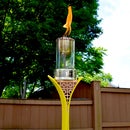Introduction: Pallet + Vintage Post = How to Make a Bee House
One of the last things I thought I’d want to make is something to attract bees, but as it turns out, building a bee house was fun and it’s an environmentally friendly and cool new part to our landscape
Step 1: Materials
I used a pallet for the base, which I wanted to make a container garden with, full of bee-friendly flowers like Black-Eyed Susan. I used a vintage porch post I’d been saving to keep the bees separated from people (even though most bees don’t sting or live in hives). And the rest came from an old pallet and some scraps I had around the shop.
Step 2: Nest Block
A bee house is essentially just a hunk of wood with holes drilled in it 3-4-inches deep. I’m no bee expert so I got a good information from Xerxes and the National Wildlife Federation. I used un-treated pallet parts for my nest block. I screwed a few together to make a cool shape. Before assembling them, I cut a 15-degree angle off the top of each block on the miter saw to shed rain. And added a miter at the bottom for a layered look.
Then, every 1-inch or so, I drilled holes about 3-inches deep. I drilled three sizes: 1/4, 3/8 and 5/16-inch. 5/16 seems to be the best for attracting Mason bees which pollinate through September according to NWF and others (and my personal and extensive bee studies…OK, maybe just NWF).
Step 3: Block to Post and Post to Pallet
To fasten the block to the post, I cut a ‘base’ out of 1-by material. I fastened the base to the bottom of the house, then to the top of the post.
To fasten the post to the pallet, I screwed a 2×6 scrap to the bottom of the post, then screwed the 2-by to the pallet. I centered the post in the middle of the 2-by, then placed the 2-by in the center of the pallet. I made sure to sink 3-inch deck screws into the structure of the pallet. I planned to use the voids in the pallet as a container garden.
Step 4: Give It a Roof and a Home in the Garden
Bees like to be dry in their little bee beds. I mean who doesn’t? So I screwed a hunk of cedar to the top of the nest block (that’s why I cut the 15-degree angle before) to shed rain. Some websites say to stay away from cedar for the nest block. Others make nest blocks out of cedar so time will tell on mine.
Step 5: Let Us Know What You Think
Send us a note, a message on Facebook or a Tweet!
Why bees? In short, bees are in trouble. And not to make it sting too much, but they don’t just pollinate our garden flowers, they pollinate our food. So, I’m not prepping, just trying to do my part like composting or recycling to help prevent the Zombie Apocalypse.













